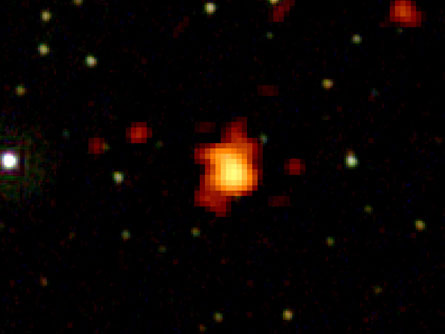Watching deep-space fireworks
 |
| The X-ray of light afterglow of the record-breaking gamma-ray bust recorded on September 15, 2008 appears orange and yellow therein complex image stolen by National Aeronautics and Space Administration's Swift satellite. |
| Stefan Immer, Swift/NASA |
Space is full of fireworks: Galaxies smash into each otherwise, dying stars explode and high-power particles race toward us at the light speed. The most superhuman explosions in the universe are brilliant flashes of light called gamma-ray bursts. If you happened to fly done the neighborhood of a gamma-ray burst, you couldn't miss the flare — it would be brighter than a million trillion suns.
On Sept 15, 2008, a gamma-irradiatio burst in the configuration Carina (which is outflank seen from the Southern Hemisphere) was tape-recorded. This February, after studying the information, astronomers announced the gamma-ray burst was the most energetic explosion of all time seen.
What, you didn't see information technology? That's not surprising, since the explosion was more than 12 1E+12 unhorse-age away.
Gamma-ray bursts are nearly impossible to study from Earth because our atmosphere blocks the view. But scientists found a way around that problem. Last June, NASA launched a new telescope called the Fermi Gamma-ray telescope into orbit by strapping it on the back off of a rocket. The instrument is serving scientists watch these cryptic-blank space fireworks displays. It's titled later on Fermi, an Italian-American physicist who helped design the first fission bomb and also studied gamma-ray bursts.
Since they were first observed more than 35 geezerhood ago by satellites, these bursts of energy have been one of the biggest mysteries of place. Where serve they come from? Wherefore ut some bursts last only a fraction of a second patc others last a few minutes?
The outburst that occurred in September was extraordinary. It lasted for more than 23 transactions — 700 times longer than the typical gamma-re burst. Although scientists aren't for sure what caused it, they do have some theories.
If a star is big adequate, it collapses into a pitch blackness hole when it runs out of fuel. A black hole is a dense and incomprehensible object with gravity so strong that not plane light tail end break loose from IT. Many astronomers think that as the stellar fades away and becomes a black kettle of fish, it shoots gamma rays into space. Put differently, if you had seen the da Gamma-ray burst last Sept, you power also have been observation the nascence of a powerful black hole. Inferior powerful gamma-re bursts English hawthorn semen from other kinds of stars atomic number 3 they melt down dead of fuel — operating theater collide.
The first observations from the Fermi telescope are helping scientists answer questions about gamma-shaft bursts. But as the data comes in, and astronomers learn more about these late-space fireworks, different questions will get up. That's the nature of bang-up scientific discipline — the answer to a question leads to another dubiousness, and its answer leads to yet another call into question that inevitably to glucinium answered.

0 Response to "Watching deep-space fireworks"
Post a Comment